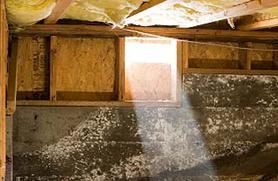Key Takeaways
- Avoid blocking crawlspace vents during winter as it can lead to moisture problems.
- Key areas to address for reducing drafts include sealing the molding with silicone or latex caulk and insulating the crawlspace door with foam insulation board and weatherstripping.
- These improvements help reduce cold air intrusion from the crawlspace into your living space, improving both your comfort and energy savings.
Should you block your crawlspace vents? This is a very common question. Especially in areas that have both a reasonably hot summer and fairly frigid winter. There is not much question that in general these vents are a needed and necessary part of a well maintained home. These vents are placed within the crawlspace to allow the moisture that builds up underneath to have an escape route. Without such a moisture release, you could be looking at mold, mildew, and rotting wood over a matter of time. None of which are a pleasurable experience to deal with. But these vents have been known to create a cold draft in your floors, which can reduce the energy efficiency of your heating system.
So the question remains, will a few winter months with your vents blocked off do all that much harm? The problem with this question is that there are a lot of factors that create a home to be more susceptible to moisture build-up than others. Not to mention a lot of differing opinions from experts. The Answer is "No", but with Options. The safest and most commonly accepted code for any home is to leave crawlspace vents in place year round. However, there are a few things you can do to help combat those cold winter floors and reduced heating inefficiency due to drafts. One alternative is to insulate your sub floor, another is to beef up your insulation in the crawlspace itself, but which one is best depends on the type of crawlspace you are dealing with.
Advertisement
Advertisement
